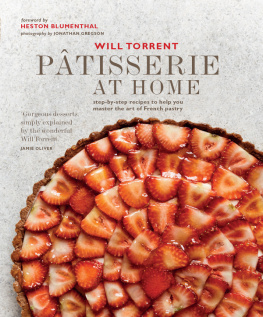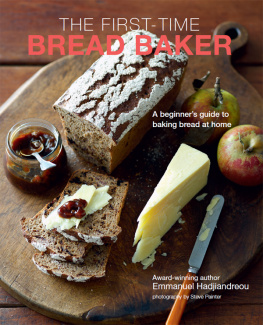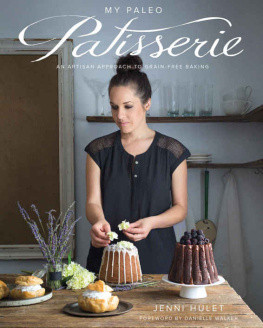Contents
About the book
FROM THE AUTHOR OF PASTRY, A BRAND-NEW, ACCESSIBLE GUIDE TO MAKING AUTHENTIC PATISSERIE AND DESSERTS AT HOME.
Many novices as well as experienced cooks want to take their pastry skills one step further. The art of patisserie is now yours to master under the expert guidance of Richard Bertinet.
In Patisserie Maison Richard takes you through basic techniques, covering the classics of the patisserie counter. With over 50 easy-to-follow recipes, including Almond clairs, Gteau St Honor, Rum baba, Paris Brest, Chocolate meringue tart and Blackcurrant mousse, and step-by-step photographs, this book opens up the world of divine sweet creations.
Originally trained as a baker in Brittany, Richard has over 20 years experience in the kitchen, baking, consulting and teaching. In 2005 he set up The Bertinet Kitchen cookery school in Bath, which now attracts people from all over the world to participate in his classes. His first book, Dough, was awarded The Guild of Food Writers Award for Best First Book, the Julia Child Award for the Best First Book and the James Beard Award for Best Book Baking and Desserts. Patisserie Maison is his fifth book.
About the author
Originally from Brittany, France, Richard Bertinet trained as a baker from the age of fourteen. Having moved to the UK in the 1980s, he is now very much an Anglophile.
With twenty years experience in the kitchen, baking, consulting and teaching, Richard moved to Bath in 2005 to open The Bertinet Kitchen cookery school. The school attracts people from all over the world to participate in Richards classes and has been highly praised, including recognition by US Gourmet magazine and the television series Adventures with Ruth [Reichl], in which it featured as one of the best cookery schools in the world.
As well as instilling passion through his teaching, Richard works as a consultant for major manufacturers developing speciality products throughout the industry.
The Bertinet Bakery started life as a weekly pop-up shop above the cookery school in 2007 but has grown to a much larger affair, producing breads and pastries for restaurants, hotels and food stores in the South West. It also supplies the bakerys own shops in Bath, with more to come further afield. The bakerys signature sourdough loaf was the winner of the Soil Associations award for Best Baked Good in 2010 and 2011.
Richards first book, Dough, received a host of accolades, including the Guild of Food Writers Best First Book Award, the Julia Child Award for Best First Book, a James Beard Award for Best Book Baking & Desserts and the International Association of Culinary Professionals Cookery Book of the Year Award. His second book, Crust, was also published to critical acclaim and received a World Gourmand Award. His third book, COOK, focused on many of the dishes taught at the cookery school. His most recent book, Pastry, was published in 2012.
Richard was named BBC Food Champion of the Year 2010 at the BBC Food & Farming Awards. For more information about Richard, The Bertinet Kitchen and The Bertinet Bakery, visit www.bertinet.com.
Introduction
When I began my apprenticeship in Britanny I had the choice of training as a baker, patissier or chocolatier. In France each one is a distinct profession with its own set of qualifications. Even though I knew that at heart I was a baker, I was always fascinated to know what my friends the patissiers were up to in the next room. Because bakers start work at two in the morning and finish at about midday, I was able to put in a double shift helping them out with the tarts and genoise sponges.
From being covered in flour and working with simple ingredients in the serenity of the bakery, where I had only one other person for company, it was such a contrast to be in the frenetic atmosphere of the patisserie, where half a dozen people seemed to do a thousand things at once. Whisks were constantly on the go and there would be fruit, cream, chocolate and sugar everywhere, and so much more washing up than in the bakery! Sunday was always the busiest day, when everyone came in to buy their desserts for Sunday lunch.
The very finest patissiers, who have risen to the top of their profession, are phenomenal artists, incredibly skilled and dedicated to the art of construction and perfect presentation but I want to show you that at a simpler level you can still achieve great-tasting and great-looking patisserie. The recipes in this book are a mix of those that we teach in our cookery school in Bath, and the kind of thing that you would find in a small boulangerie-patisserie in France. They are what I call patisserie maison: simple tarts, mousses, meringues and pastries that you can make in your own kitchen with little experience. I have tried to keep the ingredients accessible, and the techniques as simple as possible, using only basic equipment.
Most of the recipes rely on a combination of classic base recipes: genoise sponge, sweet pastry, meringue, a selection of creams and syrups, chocolate ganache, and so on. The key to making life easy is to be forward thinking and organised. When you make a sponge or pastry, for example, make double, triple or quadruple the quantity and put what you dont need immediately into the freezer. And read the recipes through first, as sometimes, especially when you are working with mousses, glazes or jellies, you will have to set each layer in the fridge before you can move on to the next. So, although a recipe might not be complicated, it might mean you need to start making it the day before you want to serve it.
We all taste with our eyes before we even put food into our mouths, so I have given a few ideas on simple, smart presentation. Sometimes just a minimal dusting of cocoa powder over a chocolate glaze, a thread of coffee run through a meringue, or a cleverly piped cream inside an clair can make the difference between ordinary and eye-catching.
Most of all, I hope that once you get to grips with the various techniques, you will have the confidence to personalise the recipes by experimenting with different combinations of flavours, textures and decorations and just have fun.
Recipe List
Genoise sponge
A good genoise sponge is one of the fundamentals of patisserie. You will find a layer of plain or chocolate sponge being used in many of the recipes in this book, such as Tiramisu (see . I suggest you bake a few trays at a time and freeze what you are not using immediately, ready to defrost when you need it. The quantity below will make enough for two shallow (2cm) rectangular sponges baked in a tray approximately 35cm 27cm.



















